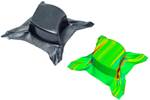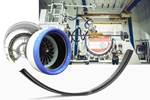Pinette commissions large-scale stamp-forming press for TPCs
Airbus Aerostructures facilities will integrate this forming press that is expected to advance next-gen aerospace parts production thanks to its size and performance.
Source (All Images) | Pinette PEI
Pinette PEI (Chalon-sur-Saône, France), an industrial solutions player for the stamp forming of composite materials, has announced the commissioning of its large-scale stamping press, a thermoplastic composites (TPC) press with 5 × 2-meter platens and a forming force of 30,000 kilonewtons (3,000 tons) that is reported to be “the largest ever designed” for stamping TPCs. Pinette expects the machine to play a key role in next-generation aerospace, where composite materials are essential for reducing weight, improving repairability and enhancing recyclability.
The development of this press required major engineering advances to guarantee optimal geometric precision and optimized thermal management. Its main features are as follows:
- Ultra-fast transfer of material from infrared heater to press in less than 5 seconds.
- Multifunctionality advancements, with autonomous robotic systems for release agent application, sensor coupling, dummy part handling and tool positioning.
- Optimized energy management using preheating and cooling stations for efficient, even heat transfer via thermal oil circulation.
- Automated tool changeover and transfer, enhancing production flexibility.
This technology will be integrated into the Airbus Aerostructures facilities in Bremen, Germany. It will support the ramp-up in production of new-generation TPC parts, boosting the competitiveness of the European aerospace industry.
Related Content
-
Update: THOR project for industrialized, recyclable thermoplastic composite tanks for hydrogen storage
A look into the tape/liner materials, LATW/recycling processes, design software and new equipment toward commercialization of Type 4.5 tanks.
-
Combining multifunctional thermoplastic composites, additive manufacturing for next-gen airframe structures
The DOMMINIO project combines AFP with 3D printed gyroid cores, embedded SHM sensors and smart materials for induction-driven disassembly of parts at end of life.
-
Braided thermoplastic composite H2 tanks with co-consolidated molded boss areas to fit EV battery space
BRYSON project demonstrates possible designs, automated manufacturing and low permeability concepts, including EVOH liner and novel PPA matrix.



